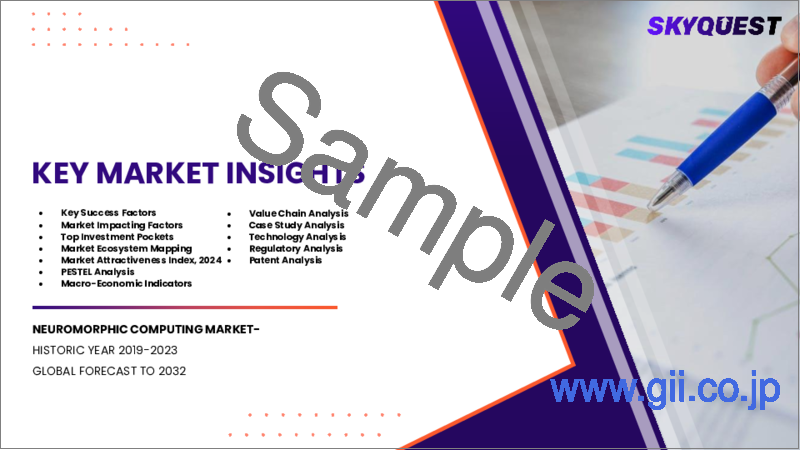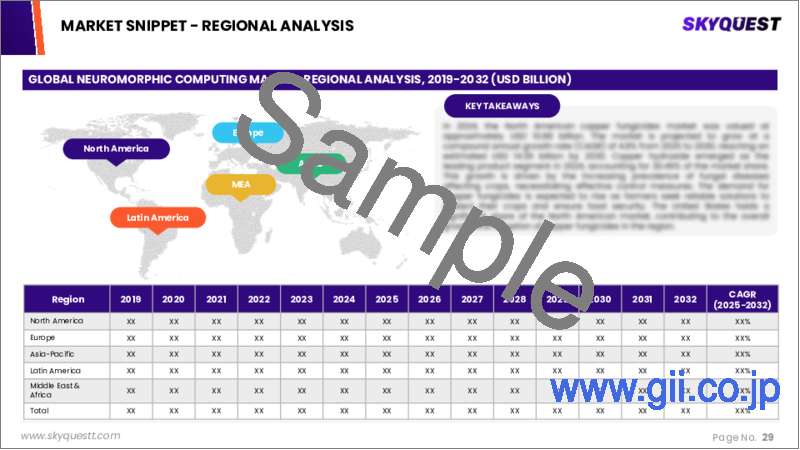|
|
市場調査レポート
商品コード
1614910
ニューロモーフィックコンピューティングの市場規模・シェア・成長分析 (コンポーネント別、展開方式別、用途別、最終用途別、地域別):産業予測 (2024~2031年)Neuromorphic Computing Market Size, Share, Growth Analysis, By Component (Hardware, Software), By Deployment, By Application, By End Use, By Region - Industry Forecast 2024-2031 |
||||||
|
|||||||
| ニューロモーフィックコンピューティングの市場規模・シェア・成長分析 (コンポーネント別、展開方式別、用途別、最終用途別、地域別):産業予測 (2024~2031年) |
|
出版日: 2024年12月15日
発行: SkyQuest
ページ情報: 英文 173 Pages
納期: 3~5営業日
|
全表示
- 概要
- 目次
世界のニューロモーフィックコンピューティングの市場規模は2022年に79億2,000万米ドルとなり、2023年の150億2,000万米ドルから2031年には2兆5,195億1,000万米ドルに成長すると予測され、予測期間 (2024-2031年) のCAGRは89.7%で成長する見込みです。
世界のニューロモーフィックコンピューティング市場は、人工知能 (AI) と機械学習 (ML) 技術の進歩により、大きな成長が見込まれています。ニューロモーフィックコンピュータのモバイルアーキテクチャは、コンパクトで効率的なコンピューティングソリューションの需要に対応し、従来のかさばるシステムと比較してスペース利用を大幅に向上させます。産業界がAIとMLをますます統合して業務効率と製品品質を向上させるにつれて、高性能集積回路 (IC) の必要性が浮上しています。メディア・エンターテインメント、家電、航空宇宙、ユーティリティ、食品・飲料、軍事などの主要セクターは、特定の課題に対処するソリューションを積極的に求めており、ニューロモーフィックコンピューティングの需要をさらに高めています。このような動向の収束により、ニューロモーフィックコンピューティング市場は予測期間を通じて堅調な拡大が見込まれ、テクノロジーの将来における重要な役割を反映しています。
目次
イントロダクション
- 分析目的
- 市場範囲
- 定義
分析手法
- 情報調達
- 二次・一次データの手法
- 市場規模予測
- 市場の想定と制約
エグゼクティブサマリー
- 市場の概要と展望
- 需給動向の分析
- セグメント別の機会分析
市場力学と展望
- 市場概要
- 市場規模
- 市場力学
- 促進要因と機会
- 抑制要因と課題
- ポーター分析と影響
- 競争企業間の敵対関係
- 代替品の脅威
- 買い手の交渉力
- 新規参入業者の脅威
- 供給企業の交渉力
市場の主な考察
- 主な成功要因
- 競合の程度
- 主な投資機会
- 市場エコシステム
- 市場の魅力指数 (2023年)
- PESTEL分析
- マクロ経済指標
- バリューチェーン分析
- 価格分析
- 技術の進歩
- 規制情勢
- ケーススタディ
- 顧客と購買基準の分析
世界のニューロモーフィックコンピューティングの市場規模・CAGR:コンポーネント別 (2024~2031年)
- 市場概要
- ハードウェア
- ソフトウェア
- サービス
世界のニューロモーフィックコンピューティングの市場規模・CAGR:展開方式別 (2024~2031年)
- 市場概要
- エッジ
- クラウド
世界のニューロモーフィックコンピューティングの市場規模・CAGR:用途別 (2024~2031年)
- 市場概要
- 信号処理
- 画像処理
- データ処理
- 物体検出
- その他
世界のニューロモーフィックコンピューティングの市場規模・CAGR:最終用途別 (2024~2031年)
- 市場概要
- 家電
- 自動車
- 医療
- 軍事・防衛
- その他
世界のニューロモーフィックコンピューティングの市場規模・CAGR (2024~2031年)
- 北米
- 米国
- カナダ
- 欧州
- 英国
- ドイツ
- スペイン
- フランス
- イタリア
- その他欧州地域
- アジア太平洋
- 中国
- インド
- 日本
- 韓国
- その他アジア太平洋地域
- ラテンアメリカ
- ブラジル
- その他ラテンアメリカ地域
- 中東・アフリカ
- GCC諸国
- 南アフリカ
- その他中東・アフリカ
競合情勢
- 上位5社の比較
- 主要企業の市場ポジショニング(2023年)
- 主要企業が採用した戦略
- 市場の近年の動向
- 主要企業の市場シェア(2023年)
- 主要企業のプロファイル
- 企業概要
- 製品ポートフォリオ分析
- セグメント別シェア分析
- 収益の前年比比較 (2021~2023年)
主要企業プロファイル
- Intel Corporation
- IBM Corporation
- Samsung Electronics Co., Ltd.
- SK Hynix Inc.
- Qualcomm Technologies, Inc.
- BrainChip Holdings Ltd.
- GrAI Matter Labs
- SynSense AG
- Nepes Corporation
- Vicarious FPC Inc.
- General Vision Inc.
- Prophesee S.A.
- Knowm Inc.
- Hewlett Packard Enterprise (HPE)
- Gyrfalcon Technology Inc.
- TECHiFAB GmbH
- Applied Materials, Inc.
- Micron Technology
- Silicon Storage Technology Inc.
- Brain Corporation
結論と推奨事項
Global Neuromorphic Computing Market size was valued at USD 7.92 Billion in 2022 poised to grow from USD 15.02 Billion in 2023 to USD 2,519.51 Billion by 2031, growing at a CAGR of 89.7% in the forecast period (2024-2031).
The global neuromorphic computing market is poised for significant growth, driven by advancements in artificial intelligence (AI) and machine learning (ML) technologies. The mobile architecture of neuromorphic computers addresses the demand for compact, efficient computing solutions, significantly enhancing space utilization compared to traditional bulky systems. As industries increasingly integrate AI and ML to improve operational efficiency and product quality, the need for high-performance integrated circuits (ICs) emerges. Key sectors such as media and entertainment, consumer electronics, aerospace, utilities, food and beverage, and military are actively seeking solutions to address specific challenges, further escalating the demand for neuromorphic computing. This convergence of trends positions the neuromorphic computing market for robust expansion throughout the forecast period, reflecting its critical role in the future of technology.
Top-down and bottom-up approaches were used to estimate and validate the size of the Global Neuromorphic Computing market and to estimate the size of various other dependent submarkets. The research methodology used to estimate the market size includes the following details: The key players in the market were identified through secondary research, and their market shares in the respective regions were determined through primary and secondary research. This entire procedure includes the study of the annual and financial reports of the top market players and extensive interviews for key insights from industry leaders such as CEOs, VPs, directors, and marketing executives. All percentage shares split, and breakdowns were determined using secondary sources and verified through Primary sources. All possible parameters that affect the markets covered in this research study have been accounted for, viewed in extensive detail, verified through primary research, and analyzed to get the final quantitative and qualitative data.
Global Neuromorphic Computing Market Segmental Analysis
Global Neuromorphic Computing Market is segmented by Component, Deployment, Application, End Use and region. Based on Component, the market is segmented into Hardware, Software, Services. Based on Deployment, the market is segmented into Edge, Cloud. Based on Application, the market is segmented into Signal Processing, Image Processing, Data Processing, Object Detection, Others. Based on End Use, the market is segmented into Consumer Electronics, Automotive, Healthcare, Military & Defense, Others. Based on region, the market is segmented into North America, Europe, Asia Pacific, Latin America and Middle East & Africa.
Driver of the Global Neuromorphic Computing Market
The global neuromorphic computing market is primarily driven by the escalating demand for energy-efficient artificial intelligence solutions. As industries seek to overcome the energy constraints associated with traditional mechanical intelligence technologies, neuromorphic systems offer a compelling alternative by emulating the brain's low-power processing. These advanced systems are particularly beneficial for applications like robotics and autonomous vehicles, where conventional hardware struggles with high power consumption and the need for real-time responsiveness. By providing a sustainable computing paradigm, neuromorphic computing addresses the critical limitations of existing solutions, positioning itself as an essential driver of innovation in the realm of AI technologies.
Restraints in the Global Neuromorphic Computing Market
The Global Neuromorphic Computing market faces significant restraints, particularly in the areas of standardization and development. The lack of uniform programming frameworks and tools tailored for neuromorphic systems creates obstacles for developers accustomed to conventional architectures. This mismatch necessitates the use of unconventional programming paradigms, complicating the coding process and hindering progress. Consequently, the absence of adequate tools and standard practices impedes the speed of development and integration, which ultimately restricts the widespread adoption of neuromorphic computing across various sectors and applications. Efforts to address these challenges are essential for advancing the technology's integration into mainstream use.
Market Trends of the Global Neuromorphic Computing Market
The global neuromorphic computing market is witnessing a significant trend towards the integration of edge computing technologies, enhancing the capabilities of neuromorphic systems. This shift enables near-instantaneous data processing and real-time decision-making, critical for applications in the Internet of Things (IoT), autonomous vehicles, and robotics. By processing data directly at the edge, organizations can reduce latency, improve efficiency, and boost overall productivity, positioning neuromorphic computing as a vital component in the evolution of smart systems. This trend reflects a broader movement towards decentralized computing architectures that cater to the increasing demand for swift and intelligent responses in dynamic environments.
Table of Contents
Introduction
- Objectives of the Study
- Scope of the Report
- Definitions
Research Methodology
- Information Procurement
- Secondary & Primary Data Methods
- Market Size Estimation
- Market Assumptions & Limitations
Executive Summary
- Global Market Outlook
- Supply & Demand Trend Analysis
- Segmental Opportunity Analysis
Market Dynamics & Outlook
- Market Overview
- Market Size
- Market Dynamics
- Driver & Opportunities
- Restraints & Challenges
- Porters Analysis & Impact
- Competitive rivalry
- Threat of substitute
- Bargaining power of buyers
- Threat of new entrants
- Bargaining power of suppliers
Key Market Insights
- Key Success Factors
- Degree of Competition
- Top Investment Pockets
- Market Ecosystem
- Market Attractiveness Index, 2023
- PESTEL Analysis
- Macro-Economic Indicators
- Value Chain Analysis
- Pricing Analysis
- Technological Advancement
- Regulatory Landscape
- Case Studies
- Customer & Buying Criteria Analysis
Global Neuromorphic Computing Market Size by Component & CAGR (2024-2031)
- Market Overview
- Hardware
- Software
- Services
Global Neuromorphic Computing Market Size by Deployment & CAGR (2024-2031)
- Market Overview
- Edge
- Cloud
Global Neuromorphic Computing Market Size by Application & CAGR (2024-2031)
- Market Overview
- Signal Processing
- Image Processing
- Data Processing
- Object Detection
- Others
Global Neuromorphic Computing Market Size by End Use & CAGR (2024-2031)
- Market Overview
- Consumer Electronics
- Automotive
- Healthcare
- Military & Defense
- Others
Global Neuromorphic Computing Market Size & CAGR (2024-2031)
- North America (Component, Deployment, Application, End Use)
- US
- Canada
- Europe (Component, Deployment, Application, End Use)
- UK
- Germany
- Spain
- France
- Italy
- Rest of Europe
- Asia-Pacific (Component, Deployment, Application, End Use)
- China
- India
- Japan
- South Korea
- Rest of Asia Pacific
- Latin America (Component, Deployment, Application, End Use)
- Brazil
- Rest of Latin America
- Middle East & Africa (Component, Deployment, Application, End Use)
- GCC Countries
- South Africa
- Rest of Middle East & Africa
Competitive Intelligence
- Top 5 Player Comparison
- Market Positioning of Key Players, 2023
- Strategies Adopted by Key Market Players
- Recent Developments in the Market
- Company Market Share Analysis, 2023
- Company Profiles of All Key Players
- Company Details
- Product Portfolio Analysis
- Company's Segmental Share Analysis
- Revenue Y-O-Y Comparison (2021-2023)
Key Company Profiles
- Intel Corporation
- Company Overview
- Business Segment Overview
- Financial Updates
- Key Developments
- IBM Corporation
- Company Overview
- Business Segment Overview
- Financial Updates
- Key Developments
- Samsung Electronics Co., Ltd.
- Company Overview
- Business Segment Overview
- Financial Updates
- Key Developments
- SK Hynix Inc.
- Company Overview
- Business Segment Overview
- Financial Updates
- Key Developments
- Qualcomm Technologies, Inc.
- Company Overview
- Business Segment Overview
- Financial Updates
- Key Developments
- BrainChip Holdings Ltd.
- Company Overview
- Business Segment Overview
- Financial Updates
- Key Developments
- GrAI Matter Labs
- Company Overview
- Business Segment Overview
- Financial Updates
- Key Developments
- SynSense AG
- Company Overview
- Business Segment Overview
- Financial Updates
- Key Developments
- Nepes Corporation
- Company Overview
- Business Segment Overview
- Financial Updates
- Key Developments
- Vicarious FPC Inc.
- Company Overview
- Business Segment Overview
- Financial Updates
- Key Developments
- General Vision Inc.
- Company Overview
- Business Segment Overview
- Financial Updates
- Key Developments
- Prophesee S.A.
- Company Overview
- Business Segment Overview
- Financial Updates
- Key Developments
- Knowm Inc.
- Company Overview
- Business Segment Overview
- Financial Updates
- Key Developments
- Hewlett Packard Enterprise (HPE)
- Company Overview
- Business Segment Overview
- Financial Updates
- Key Developments
- Gyrfalcon Technology Inc.
- Company Overview
- Business Segment Overview
- Financial Updates
- Key Developments
- TECHiFAB GmbH
- Company Overview
- Business Segment Overview
- Financial Updates
- Key Developments
- Applied Materials, Inc.
- Company Overview
- Business Segment Overview
- Financial Updates
- Key Developments
- Micron Technology
- Company Overview
- Business Segment Overview
- Financial Updates
- Key Developments
- Silicon Storage Technology Inc.
- Company Overview
- Business Segment Overview
- Financial Updates
- Key Developments
- Brain Corporation
- Company Overview
- Business Segment Overview
- Financial Updates
- Key Developments






